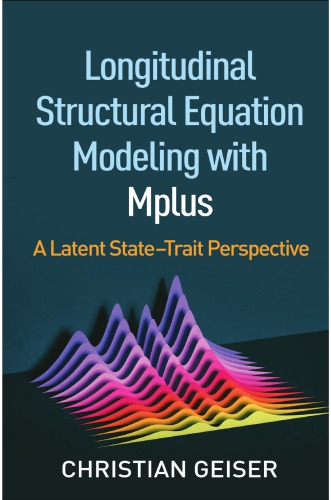

Most ebook files are in PDF format, so you can easily read them using various software such as Foxit Reader or directly on the Google Chrome browser.
Some ebook files are released by publishers in other formats such as .awz, .mobi, .epub, .fb2, etc. You may need to install specific software to read these formats on mobile/PC, such as Calibre.
Please read the tutorial at this link. https://ebooknice.com/page/post?id=faq
We offer FREE conversion to the popular formats you request; however, this may take some time. Therefore, right after payment, please email us, and we will try to provide the service as quickly as possible.
For some exceptional file formats or broken links (if any), please refrain from opening any disputes. Instead, email us first, and we will try to assist within a maximum of 6 hours.
EbookNice Team

Status:
Available4.8
15 reviews
ISBN 10: 1462538789
ISBN 13: 9781462538782
Author: Christian Geiser
An in-depth guide to executing longitudinal confirmatory factor analysis (CFA) and structural equation modeling (SEM) in Mplus, this book uses latent state–trait (LST) theory as a unifying conceptual framework, including the relevant coefficients of consistency, occasion specificity, and reliability. Following a standard format, chapters review the theoretical underpinnings, strengths, and limitations of the various models; present data examples; and demonstrate each model's application and interpretation in Mplus, with numerous screen shots and output excerpts. Coverage encompasses both traditional models (autoregressive, change score, and growth curve models) and LST models for analyzing single- and multiple-indicator data. The book discusses measurement equivalence testing, intensive longitudinal data modeling, and missing data handling, and provides strategies for model selection and reporting of results. User-friendly features include special-topic boxes, chapter summaries, and suggestions for further reading. The companion website features data sets, annotated syntax files, and output for all of the examples.
1 • A Measurement Theoretical Framework for Longitudinal Data: Introduction to Latent State–Trait Theory
1.1 Introduction
1.2 Latent State–Trait Theory
1.2.1 Introduction
1.2.2 Basic Idea
1.2.3 Random Experiment
1.2.4 Variables in LST-R Theory
1.2.5 Properties
1.2.6 Coefficients
1.3 Chapter Summary
1.4 Recommended Readings
2 • Single-Factor Longitudinal Models for Single-Indicator Data
2.1 Introduction
2.2 The Random Intercept Model
2.2.1 Introduction
2.2.2 Model Description
2.2.3 Variance Decomposition and Reliability Coefficient
2.2.4 Mplus Application
2.2.5 Summary
2.3 The Random and Fixed Intercepts Model
2.3.1 Introduction
2.3.2 Model Description
2.3.3 Variance Decomposition and Reliability Coefficient
2.3.4 Mplus Application
2.3.5 Summary
2.4 The ξ-Congeneric Model
2.4.1 Introduction
2.4.2 Model Description
2.4.3 Variance Decomposition and Reliability Coefficient
2.4.4 Mplus Application
2.4.5 Summary
2.5 Chapter Summary
2.6 Recommended Reading
Note
3 • Multifactor Longitudinal Models for Single-Indicator Data
3.1 Introduction
3.2 The Simplex Model
3.2.1 Introduction
3.2.2 Model Description
3.2.3 Variance Decomposition and Coefficients
3.2.4 Assessing Stability and Change in the Simplex Model
3.2.5 Mplus Application
3.2.6 Summary
3.3 The Latent Change Score Model
3.3.1 Introduction
3.3.2 Model Description
3.3.3 Variance Decomposition and Coefficients
3.3.4 Mplus Application
3.3.5 Summary
3.4 The Trait–State–Error Model
3.4.1 Introduction
3.4.2 Model Description
3.4.3 Variance Decomposition and Coefficients
3.4.4 Mplus Application
3.4.5 Computing the Con(τt), TCon(τt), SCon(τt), and Osp(τt) Coefficients in Mplus
3.4.6 Summary
3.5 Latent Growth Curve Models
3.5.1 Introduction
3.5.2 The Linear LGC Model
3.5.3 The LGC Model with Unspecified Growth Pattern
3.6 Chapter Summary
3.7 Recommended Readings
Notes
4 • Latent State Models and Measurement Equivalence Testing in Longitudinal Studies
4.1 Introduction
4.2 The Latent State Model
4.2.1 Introduction
4.2.2 Model Description
4.2.3 Scale Setting
4.2.4 Model Definition Based on LST-R Theory
4.2.5 Variance Decomposition and Reliability Coefficient
4.2.6 Testing ME across Time
4.2.7 Other Features of the LS Model
4.2.8 Mplus Application
4.2.9 Summary
4.3 The LS Model with Indicator-Specific Residual Factors
4.3.1 Introduction
4.3.2 Model Description
4.3.3 Variance Decomposition and Coefficients
4.3.4 Mplus Application
4.3.5 Summary
4.4 Chapter Summary
4.5 Recommended Readings
Notes
5 • Multiple-Indicator Longitudinal Models
5.1 Introduction
5.2 Latent State Change Models
5.2.1 Introduction
5.2.2 Model Description
5.2.3 Variance Decomposition and Coefficients
5.2.4 Mplus Application
5.2.5 Summary
5.3 The Latent Autoregressive/Cross-Lagged States Model
5.3.1 Introduction
5.3.2 Model Description
5.3.3 Variance Decomposition and Coefficients
5.3.4 Other Features of the Model
5.3.5 Multiconstruct Extension
5.3.6 Mplus Application
5.3.7 Summary
5.4 Latent State–Trait Models
5.4.1 Introduction
5.4.2 The Singletrait–Multistate Model
5.4.3 The STMS Model with Indicator-Specific Residual Factors
5.4.4 The Multitrait–Multistate Model
5.5 Latent Trait-Change Models
5.5.1 Introduction
5.5.2 The LST Trait-Change Model
5.5.3 Multiple-Indicator Latent Growth Curve Models
5.6 Chapter Summary
5.6.1 Advantages of Multiple-Indicator Models
5.6.2 Limitations of Multiple-Indicator Models
5.7 Recommended Readings
Notes
6 • Modeling Intensive Longitudinal Data
6.1 Introduction
6.2 Special Features of Intensive Longitudinal Data
6.2.1 Introduction
6.2.2 Wide- versus Long-Format Data
6.2.3 Imbalanced Time Points
6.2.4 Autoregressive Effects
6.3 Specifying Longitudinal SEMs for Intensive Longitudinal Data
6.3.1 Introduction
6.3.2 The Random Intercept Model as a Multilevel Model
6.3.3 The Linear Growth Model as a Multilevel Model
6.3.4 The Multitrait–Multistate Model as a Multilevel Model
6.3.5 The Indicator-Specific Growth Model as a Multilevel Model
6.3.6 Modeling Autoregressive Effects Using DSEM
6.4 Chapter Summary
6.5 Recommended Readings
7 • Missing Data Handling
7.1 Introduction
7.2 Missing Data Mechanisms
7.2.1 Missing Completely at Random
7.2.2 Missing at Random
7.2.3 Missing Not at Random
7.3 ML Missing Data Handling
7.3.1 Introduction
7.3.2 ML Missing Data Analysis in Mplus
7.3.3 Summary
7.4 Multiple Imputation
7.4.1 Introduction
7.4.2 MI in Mplus
7.4.3 Summary
7.5 Planned Missing Data Designs
7.5.1 Introduction
7.5.2 Analysis of Planned Missing Data and Simulations in Mplus
7.6 Chapter Summary
7.7 Recommended Readings
Note
8 • How to Choose between Models and Report the Results
8.1 Model Selection
8.2 Reporting Results
8.2.1 General Recommendations
8.2.2 Methods Section
8.2.3 Results Section
8.3 Chapter Summary
8.4 Recommended Readings
longitudinal structural equation modeling
longitudinal structural equation modeling workshop
longitudinal structural equation modeling in r
longitudinal data analysis using structural equation models
longitudinal structural equation
a longitudinal
Tags: Christian Geiser, Longitudinal, Structural